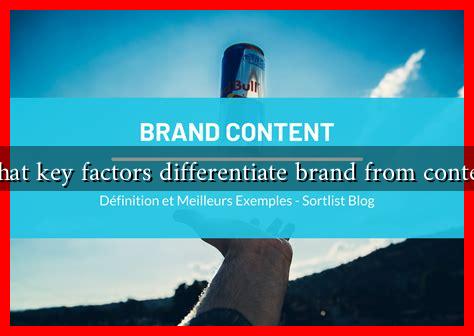-
Table of Contents
- What Key Factors Differentiate Brand from Content
- Defining Brand and Content
- Key Differentiators Between Brand and Content
- 1. Purpose and Function
- 2. Emotional Connection vs. Informational Value
- 3. Consistency vs. Variety
- 4. Longevity vs. Timeliness
- Case Studies: Brand vs. Content in Action
- Conclusion: The Interplay Between Brand and Content
What Key Factors Differentiate Brand from Content
In the digital age, the terms “brand” and “content” are often used interchangeably, yet they represent distinct concepts that play crucial roles in marketing and communication strategies. Understanding the differences between brand and content is essential for businesses aiming to create a cohesive identity and engage effectively with their audience. This article explores the key factors that differentiate brand from content, providing insights into their unique characteristics and functions.
Defining Brand and Content
Before delving into the differences, it is important to define what we mean by “brand” and “content.”
- Brand: A brand is the perception of a company, product, or service in the minds of consumers. It encompasses the values, personality, and emotional connection that a business establishes with its audience. Brands are built through consistent messaging, visual identity, and customer experiences.
- Content: Content refers to the information, entertainment, or educational material created and shared by a brand. This can include blog posts, videos, social media updates, podcasts, and more. Content serves to inform, engage, and entertain the audience while supporting the brand’s overall message.
Key Differentiators Between Brand and Content
While brand and content are interconnected, several key factors differentiate them:
1. Purpose and Function
The primary purpose of a brand is to create a lasting impression and foster loyalty among consumers. It aims to establish a unique identity that resonates with the target audience. In contrast, content serves as a tool to communicate that brand identity, providing value through information or entertainment.
2. Emotional Connection vs. Informational Value
Brands are built on emotional connections. They evoke feelings and associations that influence consumer behavior. For example, Apple is not just a technology company; it represents innovation, creativity, and a lifestyle choice. On the other hand, content focuses on delivering informational value. A blog post about the latest iPhone features provides knowledge but does not inherently create an emotional bond.
3. Consistency vs. Variety
Branding requires consistency across all touchpoints. This includes visual elements like logos, color schemes, and typography, as well as messaging and tone of voice. For instance, Coca-Cola maintains a consistent brand image that emphasizes happiness and togetherness. In contrast, content can vary widely in style, format, and subject matter. A brand may produce a how-to video one day and a humorous meme the next, showcasing the versatility of content.
4. Longevity vs. Timeliness
Brands are designed to endure over time, often evolving slowly to maintain relevance. For example, Nike has successfully adapted its brand messaging while staying true to its core values of athleticism and empowerment. Conversely, content is often time-sensitive, addressing current trends or events. A viral social media post may capture attention for a brief moment but may not have lasting significance.
Case Studies: Brand vs. Content in Action
To illustrate the differences between brand and content, consider the following case studies:
- Red Bull: Red Bull is a prime example of a brand that has successfully integrated content marketing into its strategy. The brand is synonymous with extreme sports and adventure, and its content—such as the Red Bull Stratos project—reinforces this identity while engaging audiences through thrilling narratives.
- HubSpot: HubSpot, a marketing software company, focuses heavily on content marketing. Its blog, eBooks, and webinars provide valuable insights to marketers, establishing HubSpot as a thought leader in the industry. However, the brand itself is built on the promise of helping businesses grow, which is communicated through its content.
Conclusion: The Interplay Between Brand and Content
In summary, while brand and content are distinct concepts, they are interdependent. A strong brand provides the foundation for effective content, while engaging content can enhance brand perception. Understanding the key factors that differentiate them—purpose, emotional connection, consistency, and longevity—enables businesses to create a cohesive strategy that resonates with their audience. By leveraging both brand and content effectively, companies can build lasting relationships with consumers and drive long-term success.
For further reading on the importance of brand and content in marketing, check out this insightful article on Forbes.


